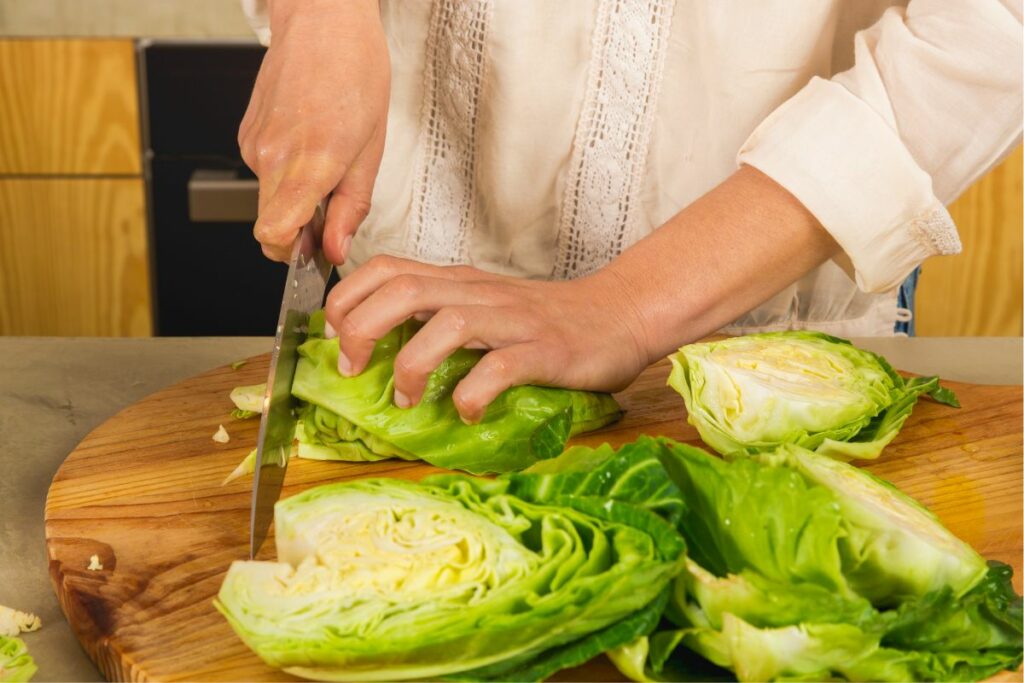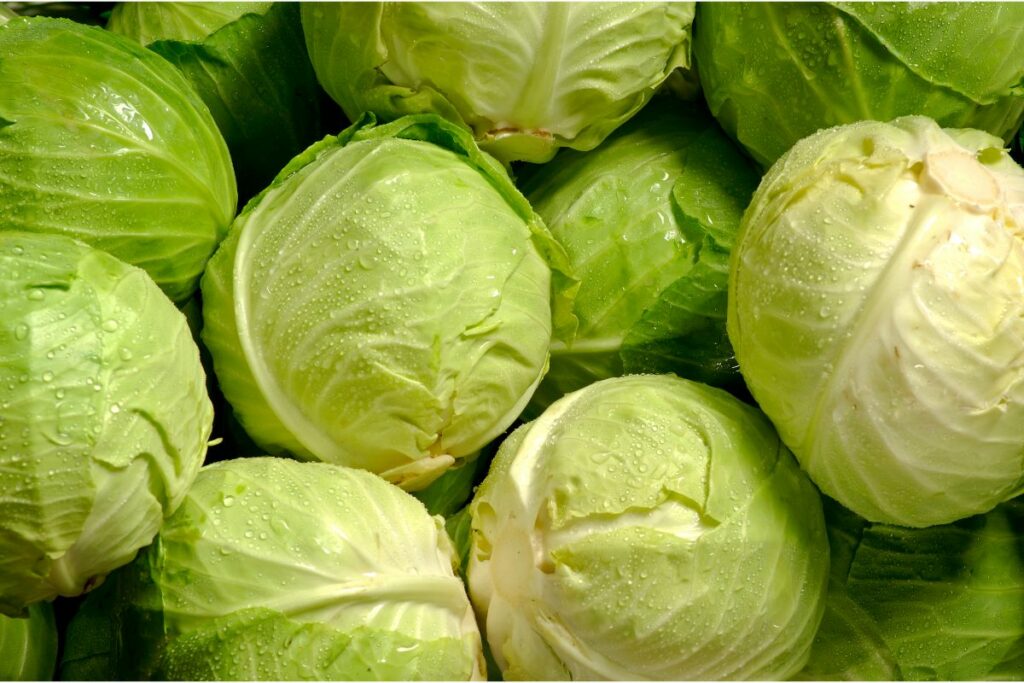They may not be everyone’s favorite, but cabbages are versatile, nutritious, and, depending on what you do with them, quite tasty!
Cabbages are used in a lot of different recipes, but if you’ve never worked with one before, cutting a cabbage can be a tricky task. How do you cut a vegetable that’s in the shape of a ball?

If you’re wondering how to cut a cabbage properly, keep reading. You’ll find a few effective methods of cutting cabbage below.
Whether you want wedges, shreds, or strips, you’ll find all you need to know about cutting cabbages in this post.
You’ll also find out some more information about different types of cabbages and their characteristics, as well as tips on picking the best cabbage for your recipes.
More About Cabbages
Cabbages resemble lettuce, but they taste very different! Cabbages are more like kale, cauliflower, and broccoli, as they are part of the Brassica family.
Raw cabbages are crisp with a light bitter flavor. This changes when it’s cooked, as the heat turns it tender and releases its sweeter notes.
Cabbages are very nutritious, as they contain several vitamins and minerals, including Vitamin C, B6, folate, and potassium!
Cabbages are inexpensive and can be used in many different recipes. You can grill, pickle, sautée, or braise the vegetable, depending on the dish you’re making.
In the beginning, cutting a cabbage may seem difficult, but we’ll get into some easy ways of slicing the vegetable later in this post.
Different Kinds Of Cabbages
Cabbages are available in several different colors and shapes. These are some popular varieties you may notice at the grocery store:
Green Cabbages
This is the most common and popular type of cabbage. Green cabbages have light green, densely packed leaves. You can use them in a lot of different ways, including shredding for salads or sautéing for stews.
Red Cabbages
Red cabbages are like green cabbages, but they have a distinct red hue. Red cabbages can be used in the same way as green cabbages.
You may find that the cabbage has a mild earthy taste compared to green, but this isn’t very strong.
Savoy Cabbages
Known as the most attractive type of cabbage, savoy cabbages are a little like green cabbages, except they have dark, beautiful green leaves that resemble lace.
When raw, Savoy cabbages are more tender compared to other varieties. This makes them a nice choice for cabbage rolls or tortilla wraps.
Napa Cabbages
Also known as the celery or Chinese cabbage, napa cabbages are slightly rectangular. They have crunchy, thick stems with light green or yellow leaves.
Napa cabbages have a light taste that works well in stir fries, though it’s often used to make kimchi.
Tips For Selecting Cabbages

Now that you know some more about cabbages, here are some tips to help you pick the best cabbages for your recipes.
- Pick up a few cabbages and see how much they weigh. Choose the ones that feel heavier than they look.
- Cabbages should appear fresh and crunchy. A few loose leaves are acceptable, but not too many. Except for napa cabbages, cabbage leaves should be tightly packed, not floppy or wilted.
- It’s best to avoid bruised heads, but if there are any tough outer leaves, you can peel these off and dispose of them.
Cutting Shredded Cabbage
This method will help you cut cabbage shreds. This is best for coleslaw, salads, stir-fries, and soups.
- Begin by removing any brown or injured outer leaves. Rinse the head with cool, clean water to remove any dirt or debris.
- Hold the cabbage head steady on a clean work surface or a cutting board. Position the head so the stem faces the ground. Find the cabbage’s core, or stem.
- Use a chef’s knife to slice the cabbage in half. Cut lengthwise, directly through the stem.
- You’ll need to cut the triangular center out to create shreds. Do this by slicing into the cabbage’s core. Slice at an angle, where the core meets the cabbage’s leaves, then pull it out from either half.
- Position the cabbage halves on your cutting board so their cut side faces the ground. Beginning opposite the core, slice crosswise to make thin shreds, working from top to bottom.
Cutting Cabbage Wedges
If you plan on braising cabbages or need pieces to roast, you’ll need to cut cabbage wedges. You’ll need to leave the stem and core intact, as this keeps the leaves together.
- Beginning from the top of the cabbage head, slice the vegetable in half, cutting through the stem’s center.
- Position the sliced, flat edge of the cabbage on your chopping board. Slice the half into quarters.
- Turn the quarters over and slice diagonally, taking the core out.
- If you like thinner wedges, slice the quarters in half once more.
Cutting Cabbage Strips
Cabbage strips work well in salads and roasts. You can make your strips longer or shorter, depending on what you want to do with them.
- Slice your cabbage head in half, working from the top of the head through the stem’s center.
- Position the cut, flat edge of the head down, then slice the cabbage in half again to make quarters.
- Turn the quarters over and slice diagonally to take the core out.
- Cut the quarters to make thin strips. If you want longer strips, slice lengthways through the cabbage quarters. If you want shorter strips, rotate the long side so it faces you, then slice crosswise.
Shredding Cabbage With A Mandolin
A mandolin is a tool that shreds, juliennes, and slices vegetables, like potatoes, carrots, and cucumbers.
You can use a mandolin to shred cabbage, which is great for making large amounts of shredded veggies for events.
- Position the mandolin on a steady surface and adjust the flat blade to your desired thickness. There should be a dial or handle to help you do this. You may need to cut cabbage quarters so they fit on the mandolin’s surface.
- With care, use the mandolin’s guard to keep your fingers safe, then slide the wedge over the blade in a swift, sweeping motion. The cabbage shreds should then drop beneath the mandolin.
- For safety reasons, don’t slice the whole wedge with your mandolin. As you get nearer the end, treat any cabbage leftovers with a chef’s knife instead.
Final Thoughts
The methods above are all effective ways of cutting a cabbage. Always take care when slicing cabbage heads, as it’s easy to slip accidentally over the vegetable’s spherical shape.
Whether you need wedges, shreds, or strips, you can refer back to this post anytime you need to cut a cabbage!
- How To Reheat A Cheesesteak - November 5, 2023
- What Are Three Must Have Kitchen Knives? - September 22, 2023
- How To Protect Edges Of Pie Crust - June 15, 2023








